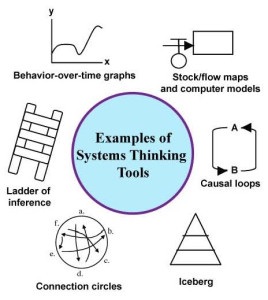Systems Thinking … what is it all about?
“Systems thinking is a way of thinking about, and a language for describing and understanding, the forces and interrelationships that shape the behavior of systems. This discipline helps us to see how to change systems more effectively, and to act more in tune with the natural processes of the natural and economic world.” … “We live in webs of interdependence.”
Credits: Peter Senge, “The Fifth Discipline”.
The key concepts are:
- “All systems are composed of inter-connected parts. The connections cause behavior of one part to affect another. All parts are connected. A change to any part or connection affects the entire system;
- The structure of a system determines its behavior. Structure is the pattern of part connections, which is how the system is organized. System behavior is at least a thousand times more dependent on connections than parts because that’s what determines how the parts work together. To understand a system’s gross behavior, understand its structure. To change a system’s gross behavior, change its structure;
- System behavior is an emergent phenomenon. How a system behaves cannot be determined by inspection of its parts and structure. This is because parts are tightly coupled, the parts and structure are constantly changing, feedback loops are present, nonlinear relationships exist, behavior paths are history dependent, the system is self-organizing and adaptive, emergent behavior is counterintuitive, time delays exist, the human mind has very limited calculation abilities, etc. Once you realize how complex the behavior dynamics of even a simple system really is, you will never again assume you can look at a system and predict how it will behave;
- Feedback loops control a system’s major dynamic behavior. A feedback loop is a series of connections causing output from one part to eventually influence input to that same part. This circular flow results in large amplification, delay, and dampening effects, which is what causes the gross behavior of the system. Every part is involved in one or more feedback loops. Systems have more feedback loops than parts, which causes unimaginable complexity. Feedback loops are the main reason a system’s behavior is emergent;
- Complex social systems exhibit counter intuitive behavior. The problems of such systems therefore cannot be solved using intuition and our everyday problem solving methods. The use of intuitive methods to solve difficult complex social system problems is a common trap, so common the entire environmental movement has fallen into it. Only analytical methods using tools that fit the problem will solve difficult complex social system problems. The first such tool to adopt is true systems thinking. The second one is a process that fits the problem. The third one, unless it is an easy problem, is system dynamics.”
www.thwink.org
Next week: More about systems thinking in education and systems thinking tools:



